Disney animator turned legendary director Tim Burton is famous for making films that have a macabre whimsy, an absurd sense of humor, and a distinct visual style. Tim Burton’s movies are sumptuous eye candy with exaggerated set designs and sharp juxtapositions between gloomy grays and vivid colors. And all of his films center on misfits and oddballs who defy social norms, whether it be real-life artists or ghosts stubbornly haunting a home.
Ahead of the release of the highly anticipated sequel Beetlejuice Beetlejuice, we figured we’d rank all of Burtons’ blockbusters. This list ranks all 19 films Tim Burton has directed since 1985, honoring a decades-long career that celebrates the weirdos of this world. Halloween has come early this year, folks.
(Note: Burton did not direct The Nightmare Before Christmas, a common misconception as he is the creator of its memorable characters.)
19. Mars Attacks!, 1996
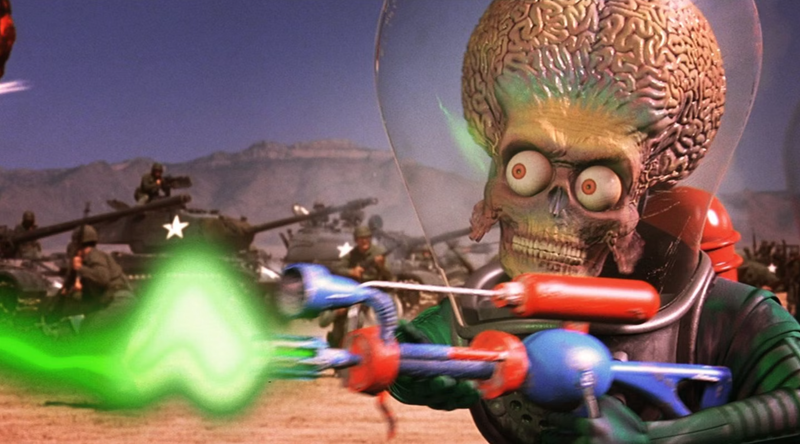
Mars Attacks! is Tim Burton at his most goofy and chaotic in an homage and parody of 1950s science fiction and B-movies. The film depicts clueless Americans being overtaken by extraterrestrials—big-brained creatures with giant heads, bulging eyeballs, and mean mugs. The obviously fake CGI is meant to honor the kitschy aesthetic of the ‘50s, but it’s so goofy-looking it’s hard to take any of it even remotely serious. The film’s cast is stacked with stars such as Jack Nicholson, Danny DeVito, Glenn Close, Annette Benning, Michael J. Fox, Martin Short, and Pam Grier, but all the star power in the world can’t make up for how Mars Attacks is nothing more than a hodgepodge of bizarre gags that are painfully unfunny and too long. All the strangeness—such as Sarah Jessica Parker’s head on a Chihuahua or the hokey skeletons people turn into when they’re zapped by Martians—feels more creepy than comical. The innocent charisma of the original B-movies is lost here and any attempts to satirize it doesn’t translate well to the 1990s.
18. Planet of the Apes, 2001
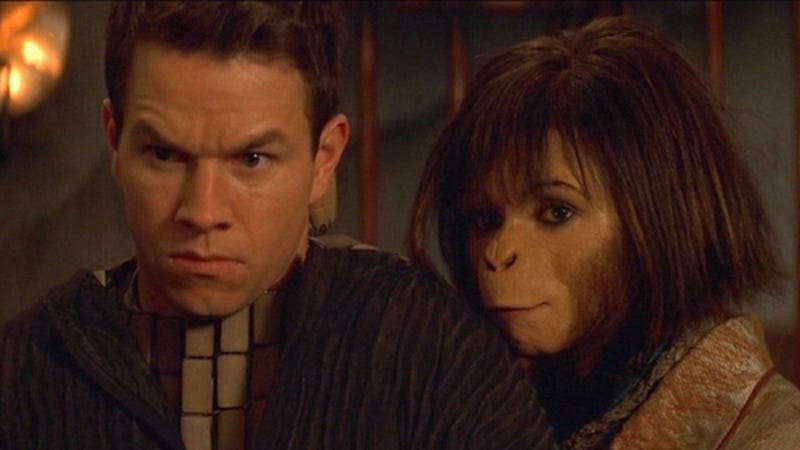
In between the sloppy sequels of the 1968 original and the epic prequel series with Andy Serkis’ stunning motion-capture performance, there was Tim Burton’s tepid 2001 remake of Planet of the Apes. The main issue with Burton’s version is that it’s either far too campy (like some of the apes complaining about a bad hair day) or struggles to deftly handle the heavier themes of race and class. Mark Wahlberg seems adrift in this blockbuster about a planet where humans are enslaved by far more intelligent apes, and is no match for Charlton Heston, who starred in the first film. The clear standout of The Planet of the Apes is artist Rick Baker’s incredible special FX makeup, which seamlessly transformed well-known actors such as Tim Roth, Helena Bonham Carter, and Paul Giamatti into primates while still retaining some of their recognizable features.
17. Dark Shadows, 2012
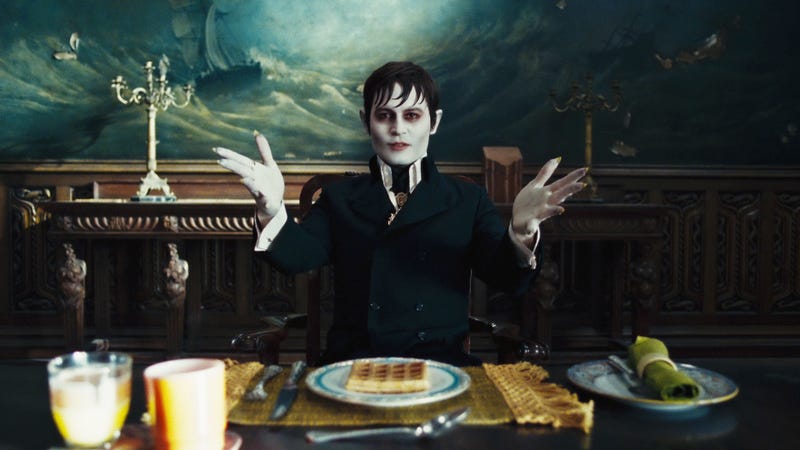
Tim Burton is all over the place trying to adapt Dark Shadows, a popular soap opera from the 1960s about a wealthy vampire Barnabas Collins in a centuries-long feud with the witch Angelique Bouchard. Of course, Collins’ sprawling Maine estate looks incredible, showcasing Tim Burton’s signature Gothic style with ominous spires and stone statues displayed with exquisite attention to detail. The dramatic lighting and wide shots, which take in dust-covered chandeliers and old-fashioned paintings, bring the mansion to life in ways the original television show never could. But for all its spellbinding production design, the story is lacking.
While Tim Burton is usually an expert at striking the right tone, he doesn’t know whether to lean into the campiness or scariness, resulting in a film that toes a boring line down the middle. Rather than indulging us in another chameleonic performance, Johnny Depp seems to be sleepwalking, making this his weakest collaboration with Burton to date (and, thus far, his last). Most of the magnetic power comes from the female cast such as Eva Green and Michelle Pfeiffer. Dark Shadows fails to capture the essence of the original series and doesn’t add anything of its own.
16. Dumbo, 2019

With an eye for marvels and curiosities, Tim Burton has always had a thing for circuses, and they have appeared in most of his films. So, who better to direct a new Dumbo movie and tell the tale of a baby circus elephant rejected for his enormous ears who discovers he can fly? With his big blue eyes, the CGI version of Dumbo is just cartoony enough to avoid the uncanny valley of the ultra-realism seen in The Lion King “live-action” adaptation. But the issue with Burton’s version, as with many live-action Disney flicks, is that it stretches a short film into a nearly two-hour one.
While some changes, such as removing Timothy Q. Mouse and the racist crows, were necessary, the post-World War I story of a one-armed veteran and his children who take care of Dumbo isn’t engaging enough—despite all of Colin Farrell’s charms. Try as we may to invest in them, we just want to return to the main attraction: Dumbo. Unfortunately, Dumbo is Tim Burton’s ugliest film with haphazard CGI and muted colors that make it seem like the camera lens was smeared with mud. The only thing Dumbo has going for it is that the elephant is really, really cute.
15. Alice in Wonderland, 2010
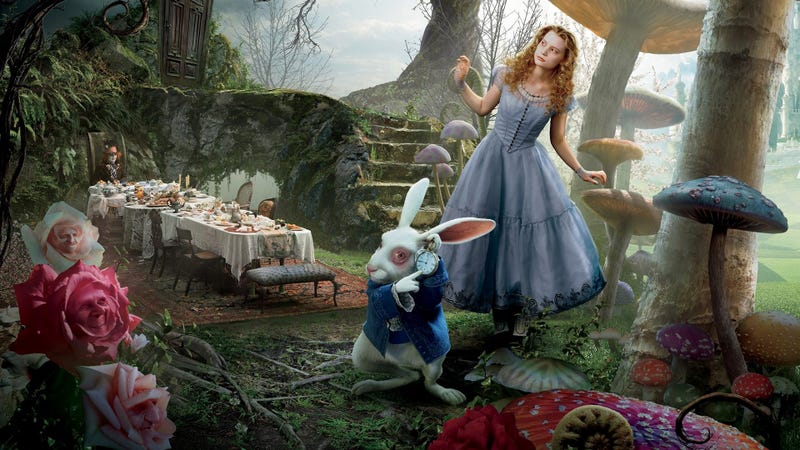
On the surface, a Disney live-action remake of Alice in Wonderland seems like a perfect fit for Tim Burton. While the 2010 Alice in Wonderland has everything that makes a Tim Burton movie so uniquely his—enchanting yet strange character designs, a Victorian Gothic aesthetic, and exquisitely-detailed, surrealistic sets—it still somehow manages to be lackluster.
The film’s standouts are its main characters, whose spooky qualities contribute to a more twisted version of Wonderland. Johnny Depp’s Mad Hatter, with his pale face, bright green eyes, and orange frizzy hair, resembles a crazed clown, while Helena Bonham Carter’s Red Queen has a giant CGI head to emphasize her haughtiness. Tweedledee and Tweedledum, with their eerie sunken eyes and rotund bodies supported by tiny, thin legs, recall The Penguin from Batman. But this version of Alice in Wonderland attempts to inject a bland, #girlpower brand of feminism into Alice’s character. She becomes a warrior leading boring battle sequences set against dull grayish hues.
This type of expansion on the original narrative, often in service of creating stronger female characters, would become a hit-or-miss trend in future Disney live-action adaptations. Despite all the visual abundance, Alice in Wonderland falls short.
14. Miss Peregrine’s Home for Peculiar Children, 2016

The cover of Ransom Riggs’ book Miss Peregrine’s Home for Peculiar Children looks exactly like a Tim Burton movie: black and white, featuring a creepy Victorian child, and bare, bent trees in the background. The book and movie follows a young boy who discovers a group of children with paranormal abilities known as the “Peculiars,” and their time-looping caretaker who can transform into a peregrine falcon. As Miss Alma Lefay Peregrine, Eva Green has a quiet, intense presence that makes her performances hypnotic to watch. Emma Purcell, playing a girl who can manipulate air, is another highlight, her expressive, owl-like eyes convey an earnestness that drives the story forward.
In Burton’s hands, the Hollowgast villains are transformed into surreal, nightmarish creatures with pale bodies, eyeless heads, sharp teeth, and multiple pointed tongues. While the imaginative premise, peculiar characters, and Victorian mansion setting are undeniably Burtonesque, there are too many plot and pacing issues. Miss Peregrine’s Home for Peculiar Children feels rushed and uncaring in the emotions of what’s happening on screen, merely hitting the story beats of the YA phenomenon to set it up for future sequels.
13. Pee-wee’s Big Adventure, 1985
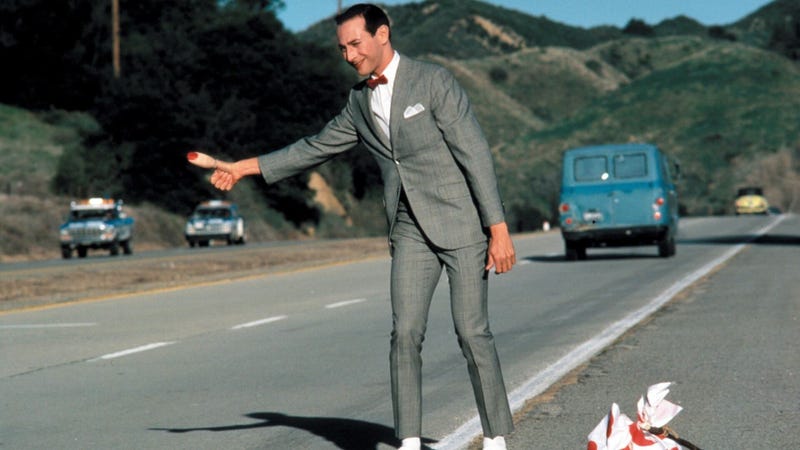
Pee-wee scared me as a young child, so I was never a big fan of Pee-wee’s Big Adventure, though I know it’s a nostalgic favorite for many. Paul Reubens’s over-the-top performance as the optimistic boy who never grew up and in search of his bicycle was too grating; his wild antics, such as dancing for a motorcycle gang or sneaking onto a Warner Bros. lot, were too goofy. But as Tim Burton’s debut feature film, it’s an important showcase for the quirky aesthetic he would soon become famous for. The dream sequences in particular, with killer clowns and a stop-motion T. Rex, have the kind of scary playfulness that foreshadow his later work. Pee-wee’s Big Adventure has a relentless childlike absurdity that many find charming—especially younger audiences. But if you don’t find Pee-wee funny or cute, there’s not much here aside from the eye-popping special effects.
12. Big Eyes, 2014
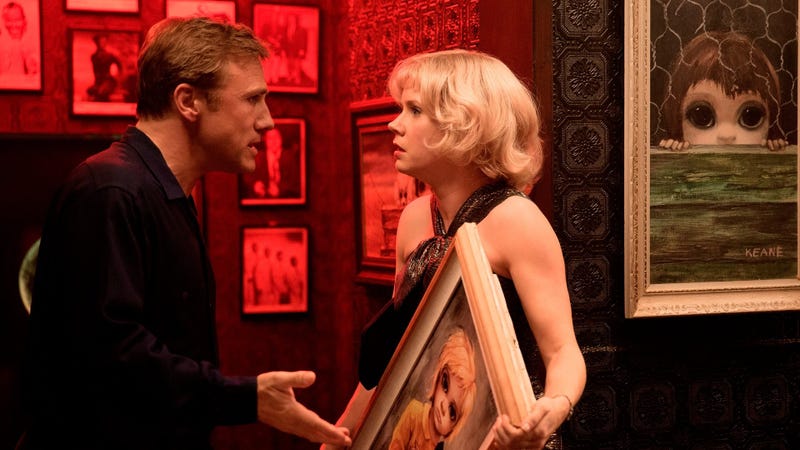
Big Eyes is a biopic of a misunderstood artist, and while it doesn’t hit the emotional or visual highs of Ed Wood, it’s anchored by a nuanced performance from Amy Adams as Margaret Keane, the real woman behind the famous paintings of sappy-eyed children (her abusive husband, Walter Keane, passed himself off as the true artist). It’s the little moments that make Amy Adams’ performance, everything she doesn’t say as she tightens her lips or the flickering disappointment in her eyes over her husband’s lies. Once again, Tim Burton uses color to communicate the story’s emotions: the joys of their early marriage are bathed in saturated colors but become darker with cooler tones during their conflicts over the paintings. It’s refreshing to see Tim Burton explore the intimate lives of ordinary people; he does it so well that one wishes he would more often.
11. Charlie and the Chocolate Factory, 2005

Some may say it’s sacrilegious to prefer Tim Burton’s Charlie and the Chocolate Factory over the 1971 original starring Gene Wilder, but Tim Burton’s style is perfectly suited for the story of a young boy who wins a contest to explore a mysterious candy maker’s factory. Tim Burton lovingly crafts Willy Wonka’s vast candy palace with built sets instead of CGI, filling them with bright, green grass, giant candy cane trees, and a chocolate waterfall. All the sweet goodies look glossy and almost too perfect to be real. Burton creates a striking contrast between the wondrous factory and the drab, industrial town in which it resides, with Charlie’s thatched house exaggeratedly leaning to one side.
With a lighthearted voice and fussiness, Johnny Depp creates a version of Willy Wonka that is less psychopathic than Gene Wilder’s. He’s funnier and has more emotional depth, more like a socially inept, overgrown child with daddy issues. We sympathize with him as we learn more about his traumatic childhood and strained relationship with his father, played by the great Christopher Lee.
Instead of the horrifying, hypnotic drone from the original, Burton’s Oompa-Loompa musical sequences are catchy and fun, using a variety of genres from heavy metal to hippie folk. Charlie and the Chocolate Factory uses pre-existing material that was perfect for the Burton’s brand of childlike wonder and weirdness.
10. Corpse Bride, 2005
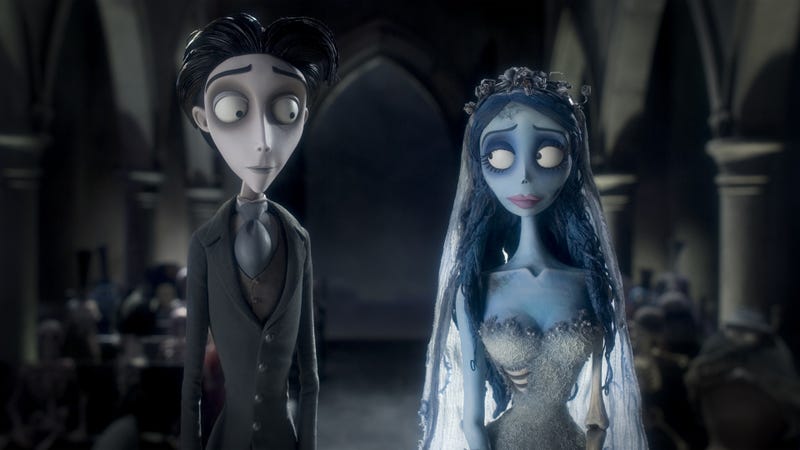
Corpse Bride is another one of Tim Burton’s stop-motion masterpieces. Johnny Depp sounds so different from his other roles as the shy and skittish Victor who, shortly before his arranged marriage, accidentally marries a dead socialite named Emily. She brings him to the very lively Land of the Dead, filled with bright green, purple, and blue hues, toe-tapping musical numbers, and kooky skeleton characters (including an adorable dead dog named Scraps).
Burton clearly enjoys juxtaposing this surprisingly upbeat world with the dour, stuffy grays of Victorian England. Corpse Bride features all kinds of creative, gross-out humor, such as a maggot that pops out of Emily’s eye socket. Many of the deceased characters in Corpse Bride resemble the way they died, such as a pair of generals with cannon holes and swords in their stomachs—Victor’s bumbling and terrified interactions with them are hilarious.
There’s also very moving moments, like Emily’s murder by her fiancé for her fortune. Helena Bonham Carter’s feathery voice conveys a wounded young woman, and her singing is beautifully haunting. One particularly touching scene with butterflies will bring you to tears. Corpse Bride is funny yet melancholy, creepy yet cute, and a whole lot of fun. It proves that kids can enjoy dark stories, too.
9. Batman, 1989
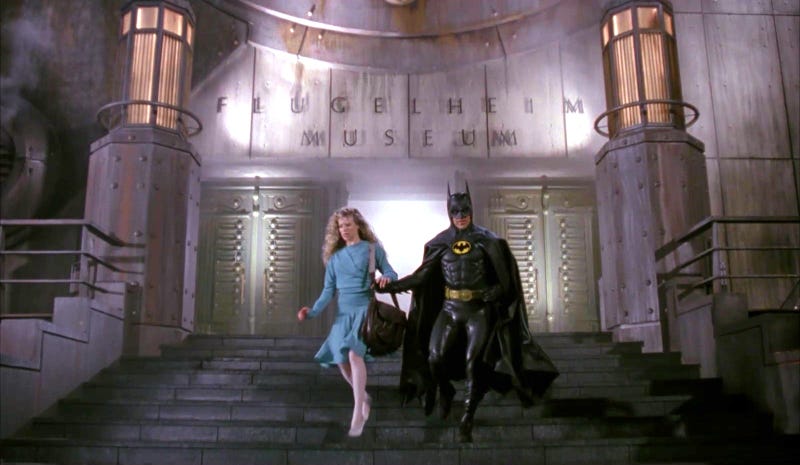
Tim Burton’s flamboyant, Gothic style is perfect for bringing the shadowy city of Gotham to life in Batman. Burton transforms Gotham into a living, breathing urban jungle that perfectly matches Bruce Wayne’s tortured self. The cramped buildings with sharp spires and bold facades are reminiscent of German Expressionist movies such as Fritz Lang’s Metropolis and F. W. Murnau’s The Last Laugh.
Despite the exaggerated sets, Batman is grounded by Michael Keaton’s performance; he shades Batman and Bruce Wayne with a blend of coolness, toughness, and vulnerability. His soft, composed Batman voice indicates a hidden strength and steady confidence that other actors playing Batman rarely have. Jack Nicholson, of course, is iconic as the Joker, delivering a wonderfully ostentatious performance with his trademark cheeky smile; he behaves like the manic ringleader of a twisted circus.
It may not be the best Batman adaptation—that honor belongs to the Christopher Nolan trilogy—but it has a darkly atmospheric look thanks to Burton’s direction that effectively taps into the pulpy aspects of the comic book.
8. Batman Returns, 1992
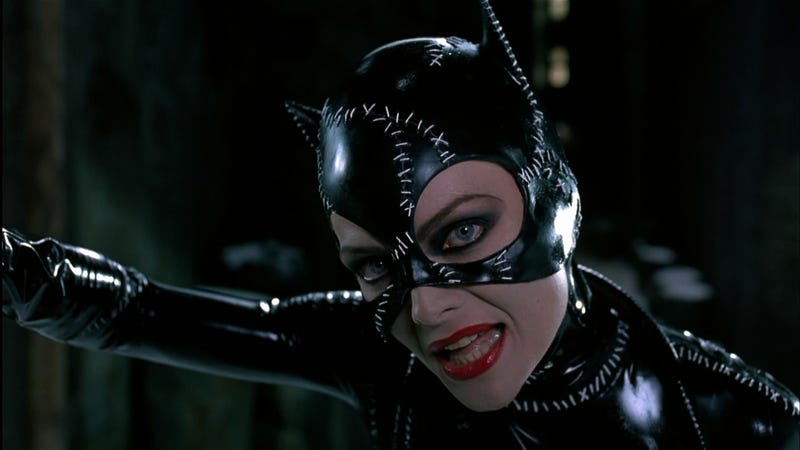
Batman Returns starts off with a grimness not found as much in other Batman films. After discovering their child has physical differences, a snooty rich couple dumps his cradle in a freezing river—on Christmas, no less! Backed by the eerie choir of Danny Elfman’s score, it travels down to the grimy sewers where penguins wander.The film is defined by this type of cruelty, particularly in Danny DeVito’s Penguin. He is a loud, brash character with a grotesque appearance—lumpy and misshapen with a beak-like nose. His short and round features, waddling walk, and volatile outbursts make him seem more animal-like than human.
DeVito’s campy performance is the true highlight of Batman Returns, along with Michelle Pfeiffer as Catwoman, of course. Her performance is delightfully unhinged and exudes eroticism, particularly in her BDSM-esque leather suit and enjoyment of tying people up. The movie has cartoony elements, like the Penguin driving a giant duck car, but there’s also intense violence where he bites off a man’s nose and blood oozes in between his teeth; another man is electrocuted, his white eyes popping out of his burnt, crispy flesh.
Batman Returns is far more interesting and visually dynamic than the first because it leans into a certain kind of loony ugliness that only Tim Burton could create.
7. Sleepy Hollow, 1999
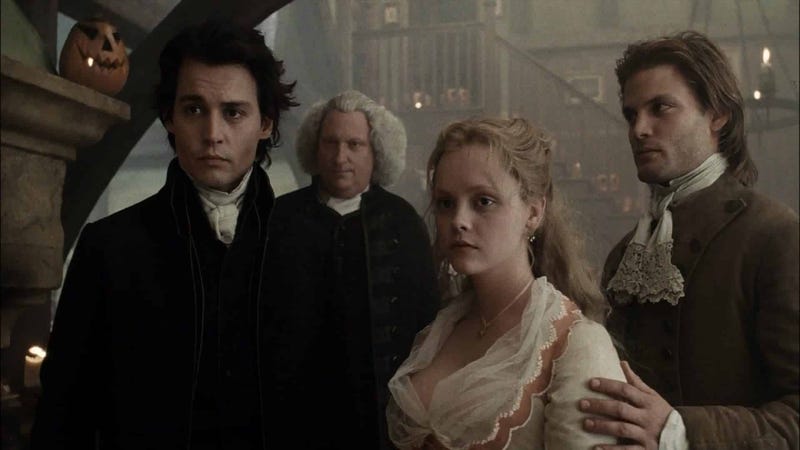
Sleepy Hollow is one of Tim Burton’s most gorgeous films, flaunting a rich, Gothic aesthetic that recalls the bold Hammer horror classics. The images of plunging bodice necklines, gnarled trees, misty roads, and thatched-roof cottages create a dark and detailed period film. Every shot is drenched in somber grays and blacks, giving all of the characters ghostly facial hues while making the rivers of blood in this very gory movie pop off the screen.
Johnny Depp’s performance is a big part of what makes Sleepy Hollow work so well as a vibrant mix of campiness, black humor, and genuine terror. He fully embodies the persnickety Ichabod Crane who believes more in science than the supernatural. He has a toolkit of bizarre inventions, including a set of bug-like eyepieces that he likes to fiddle with, but he gets sick having to conduct autopsies and wound examinations of the headless victims. Sleepy Hollow builds to a thrilling climax with Christopher Walken as the evil Headless Horseman.
As one of Tim Burton’s best, Sleepy Hollow is one of the few horror movies where you have lots of fun but also get chills.
6. Sweeney Todd: The Demon Barber of Fleet Street, 2007
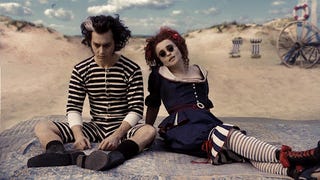
Sweeney Todd: The Demon Barber of Fleet Street resembles Sleepy Hollow in its meticulous period detail and dreary, overcast colors—the red blood from slashed throats is brighter than anything on screen. Johnny Depp stars as Sweeney Todd, a man who loses his wife and daughter to the evil Judge Turpin and returns from imprisonment in Australia seeking vengeance.
Depp’s singing voice has a rock and roll edge that really works for the character and articulates his raw, heartbroken rage. Sweeney forms a devious partnership with Mrs. Lovett, murdering his barbershop clients and turning them into meat pies in preparation for his reckoning with Turpin. Helena Bonham Carter’s vocals, on the other hand, are far too soft and weak for a character as brash as Mrs. Lovett.
Burton adds a touch of his whimsical flair to some of the scenes, particularly Mrs. Lovett’s fantasy “By the Sea” where Sweeney Todd wears a Beetlejuice-esque black and white bathing suit. All of the musical numbers have this type of creative vision and fluid and dynamic camera movements. Sweeney Todd is a killer mix of horror, black humor, and melodrama, and one of Burton’s bests.
5. Frankenweenie, 2012
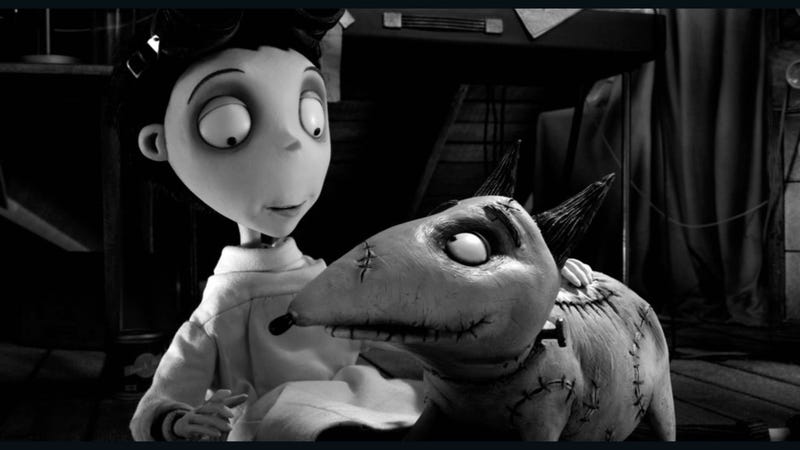
Back in 1984, Tim Burton was working for Disney as an animator and completed a short film, Frankenweenie, based on Mary Shelley’s classic Frankenstein, about a boy named Victor Frankenstein who uses electricity to resurrect his dead Bull Terrier, Sparky. Ironically, Disney ended up firing Tim Burton for making a kids film that was too frightening, but in 2012, Tim Burton was able to make a 3D, stop-motion version of his short.
The new Frankenweenie is sophisticated and touching, reflecting Tim Burton’s many years as a seasoned filmmaker. The sharp, black-and-white visuals make the impressive quality of the puppets really stand out, particularly the odd little children with giant saucer eyes and little dots for pupils, and the adorable, energetic Sparky.
Set in 1957, the monochromatic Frankenweenie serves as a tender homage to the classic monster movies that inspired Tim Burton growing up. Frankenweenie has a childlike sensibility with its morbid and gross humor, but there’s also a sweetness that comments on the special bond between children and their pets. It’s a wonderful family film that was clearly made with Tim Burton’s heart and soul.
4. Ed Wood, 1994
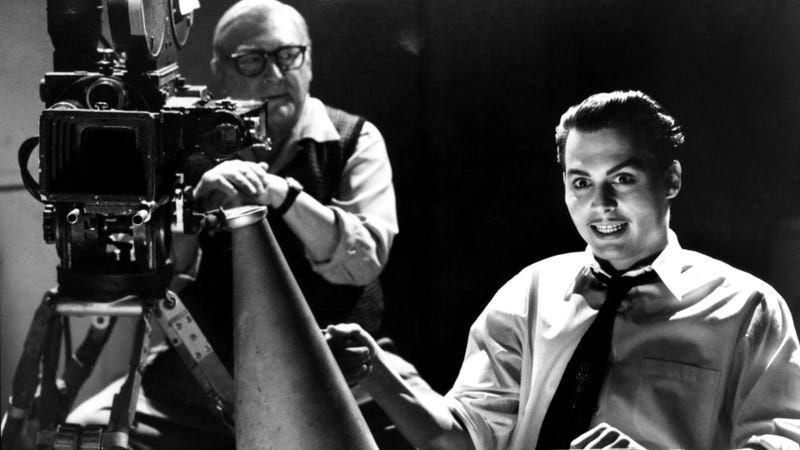
Ed Wood is a straightforward biopic that is shot in crisp black and white to evoke the schlocky sci-fi and horror movies of the 1950s. Ed Wood was a Hollywood outcast who directed fiascos with threadbare budgets and past-their-peak movie stars. As Ed Wood, Johnny Depp brings a determined cheerfulness to the role that is difficult to resist. The scenes of Ed’s on-the-fly movie-making are hilarious, showing a director who likes to shoot everything in one take, no matter what. He just enjoys the process of making a movie! The emotional heart of the film is Ed Wood’s relationship with Bela Lugosi, a formerly famous horror actor struggling with drug issues, played by a superb Martin Landau. Ed Wood’s life story was a perfect match for a Tim Burton film because he has such an affection for outsiders. That tenderness and care shines through in Burton’s treatment of this unique slice of Hollywood history.
3. Beetlejuice, 1988
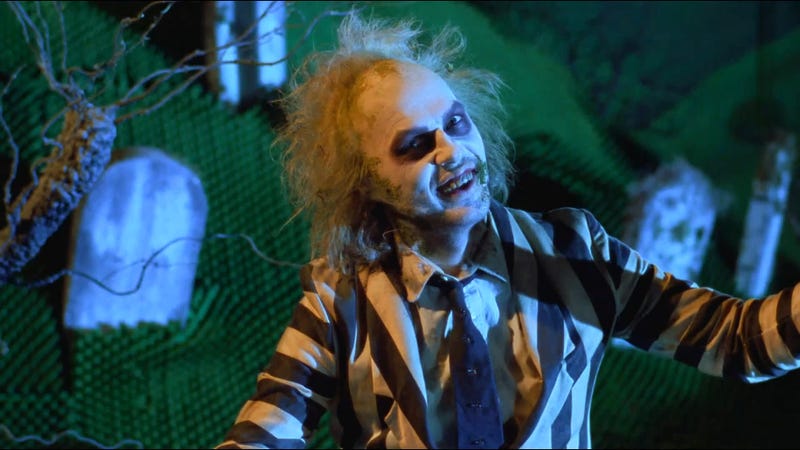
Beetlejuice embodies everything we love about Tim Burton: It’s one of the weirdest movies ever made, about a rebellious demon named Betelgeuse who is hired by a wholesome, recently-deceased couple to “exorcize” the living people out of their home.
The filmfeatures incredible practical effects, from shrunken-head creatures and decomposing bodies to the giant sandworms, all of which strike a perfect balance between cartoonish and creepy. Michael Keaton delivers an unforgettable performance as the title character, completely transforming himself with a spastic walk, electric-socket hair, and peeling green skin. He is an uncouth showman whose evilness manifests in irreverent humor and boundary-crossing antics. All of the characters in Beetlejuice are striking, and the performances are equally memorable, from Alec Baldwin and Geena Davis as the ghost couple, to Catherine O’Hara as the melodramatic sculptor, and Winona Ryder as the enigmatic teenage Lydia.
Beetlejuice is a delightfully absurd and creative romp that depicts the sunny, all-American innocence of suburbia with a macabre twist, topped off with demon-possession musical numbers by Harry Belafonte It’s this oddball mix that not only makes it a great movie, but a Halloween favorite.
2. Big Fish, 2003
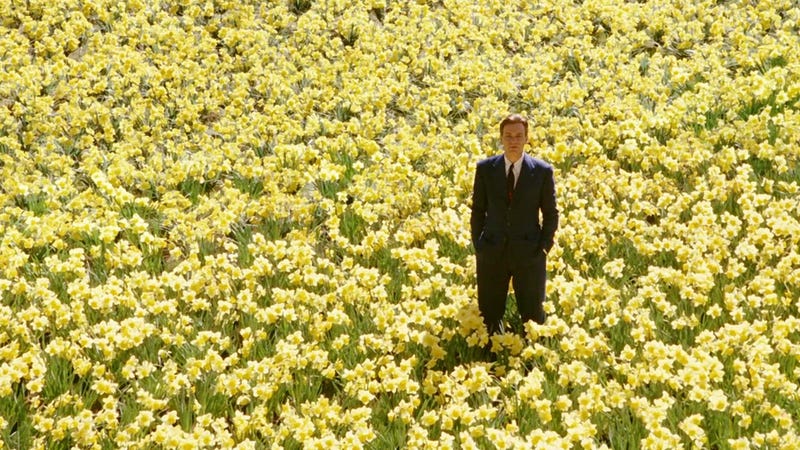
Big Fish is Tim Burton at his most human and introspective while still retaining his spectacular and singular vision. Albert Finney and Ewan McGregor are perfectly cast as the older and younger version of Edward Bloom, a charismatic salesman with a love of adventure and a twinkle in his eye. Edward loves to share colorful stories about his life kissing mermaids, catching a massive fish, meeting a giant at the circus, and witnessing his future in the glass eye of a witch, all of which are visual spectacles full of fantastical settings, vibrant colors, and dreamlike details.
After dazzling us with whimsy and setting up the core problem (Edward’s son, William, played by Billy Crudup, is tired of his father’s tall tales), Big Fish reaches a highly emotional climax that solidifies the film as one of Tim Burton’s best. Beautiful and sentimental, Big Fish reminds us of the importance of family and sharing memories and stories with one another so our legacy lives on.
1. Edward Scissorhands, 1990

Edward Scissorhands is Tim Burton’s crowning achievement, marking a significant departure from his more comic or action-oriented films that gives the eccentric aesthetic he’s known for a profound emotional gravitas. It’s also the first time Tim Burton worked with Johnny Depp, who would go on to star in seven more of his films.
Depp plays a young man with scissors for hands who is taken in by a kindhearted Avon lady. With minimal dialogue and an unassuming presence, his performance resembles a silent film actor’s. In frequent close-ups, Johnny Depp communicates so much through his sad brown eyes: confusion, child-like innocence, a broken soul. Winona Ryder plays the blonde cheerleader whom Edward falls for, and their unspoken, empathetic connection draws you into the classic story of an ostracized “beast” falling for a beauty.
Unlike Tim Burton’s other films, which often emphasize the comedic elements of his fanciful settings, this one juxtaposes the monotonous rows of pastel-colored houses with the ink-black Gothic castle where Edward lives to make thoughtful observations on societal rejection of outsiders and people with differences. There are so many moments that feel straight out of a storybook, such as when Kim twirls in the “snow” created by Edward, accompanied by Danny Elfman’s enchanting choral score.
Edward Scissorhands is not only Tim Burton’s best film, but one of the greatest modern fairy tales ever told.

Leave a Reply